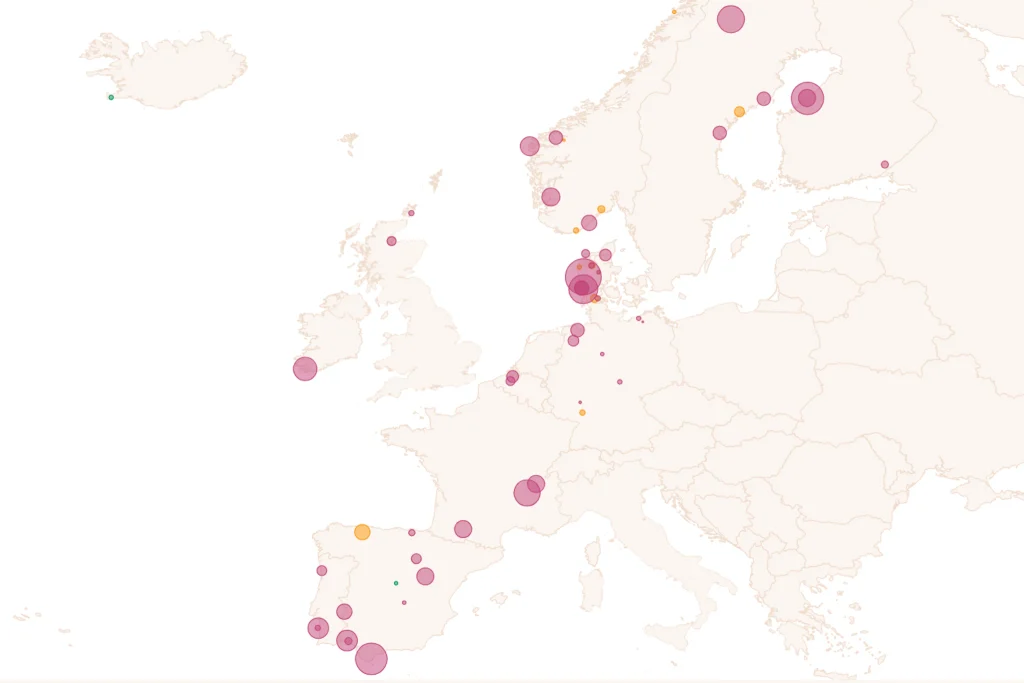June 3, 2024 - TEA
The 4% of European shipping could run on synthetic fuels in 2030, according to the map prepared by T&E. But only a third of these projects are guaranteed, as fuel suppliers fear a lack of demand.
A new study of Transport & Environment (T&E) reveals that two thirds of European green shipping projects are at risk. T&E's study of green hydrogen projects in Europe shows that almost 4% of European shipping could be powered by green fuels by 2030. But fuel suppliers seem reluctant to commit financially to projects without further guarantees that there will be demand for these fuels in the near future. This means the vast majority of projects may never get underway this decade, putting Europe's climate ambitions and thousands of jobs at risk, T&E warns.

Source: T&E's e-Fuels Observatory
"Hydrogen projects are emerging across Europe. They have the potential to boost hard-to-decarbonize sectors, such as shipping, and create thousands of jobs. But at the moment there is not enough certainty and we risk missing this opportunity to gold".
Carlos Rico, transport energy expert at T&E Spain
There are at least 17 projects across Europe that can supply ships with green hydrogen-based fuels. If all of these projects come online, they could meet almost 4% of total EU shipping energy demand in 2030. T&E has identified a further 44 hydrogen projects in Europe that could also supply green fuels to ships, however The promoters of these projects also have in mind other industries that are equally hungry for hydrogen.
The projects outlined would easily meet the European Union's goal of 2% of green fuels in 2034; however, most projects have not yet received funding and not a single one dedicated to maritime transport is operational. fuel producers quote The main obstacles are the lack of certainty of buyers and security of investments. This puts millions of tonnes of green fuels and thousands of skilled jobs at risk. On a global scale, it calculate that green shipping could create 4 million new jobs by 2050.
Spain hosts a third of fuel supply projects
The T&E report reveals that when it comes to fuel projects for maritime transport, Spain leads the list of European countries. In fact, it hosts a third of the fuel supply projects for this sector.
An opportunity that would be in line with the new maritime security strategy recently presented by the Spanish government, which proposes the development of photovoltaic plants to generate green hydrogen as a strategic move to counteract the energy dependence on foreign countries that, in 2022, was in the 70%.
It also highlights the importance of Spain as the first country in contribution to the Blue Economy of the European Union in terms of employment and gross added value, with figures exceeding 944,000 jobs and a generation of more than 32.7 billion euros.
On the other hand, another relevant country is Denmark, which represents more than half of the hydrogen volumes planned in the 61 projects analyzed by T&E. But curiously, despite its long coastline, the UK has very few projects, while T&E found none in Italy and Greece.
In the long term, zero-emission ammonia appears to be the most popular option, with 77% of potential volumes. To date, however, none of these projects have received a final investment decision.
"Marine transport has a chicken and egg problem. Producers of synthetic fuels are waiting for clearer signals of demand from shipowners before making large investments. Operators, for their part, are waiting for these fuels to grow and become cheaper to sign purchase agreements. The EU must guarantee greater supply and demand for green fuels through regulation, which will provide fuel producers and shipping companies with investment security."
Carlos Rico,
T&E recommends that Member States mandate that at least 1.2% of shipping fuels be green fuels by 2030, as recommended by the EU Green Fuels Directive (RED III). This would secure all current projects that have already received funding and allow more projects to reach the final investment decision. Revenue from the EU Carbon Market for Shipping (ETS) should also be used to support nascent projects, T&E says.
Just this week the European Union approved the channeling of state financing from several EU governments to promote the development of this technology. Up to €1.4 billion from France, Germany, the Netherlands, Italy, Slovakia, Spain and Estonia will be added to another €3.3 billion in private financing.
It covers 13 projects for 11 companies, including fuel cell technologies that could generate energy to move ships, including onboard storage solutions to enable the use of hydrogen in other modes of transportation such as airplanes. This financial support is timely but it is not enough; It is also necessary to boost demand through the introduction into Spanish regulations of a mandatory quota of at least 1.2% of green fuels in maritime transport by 2030.

